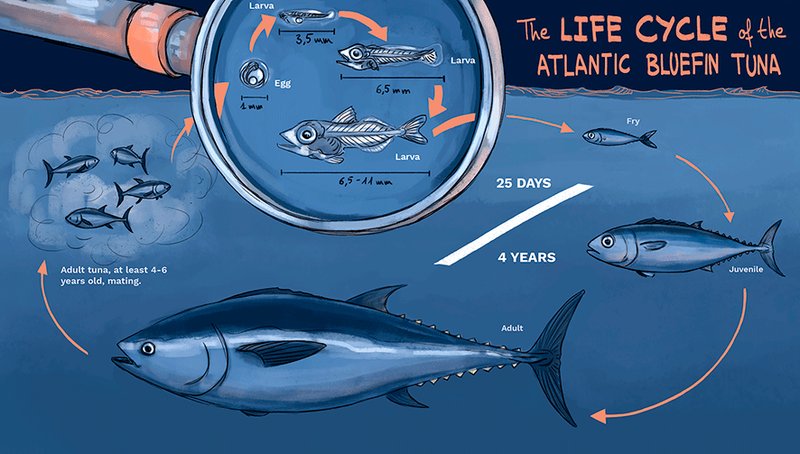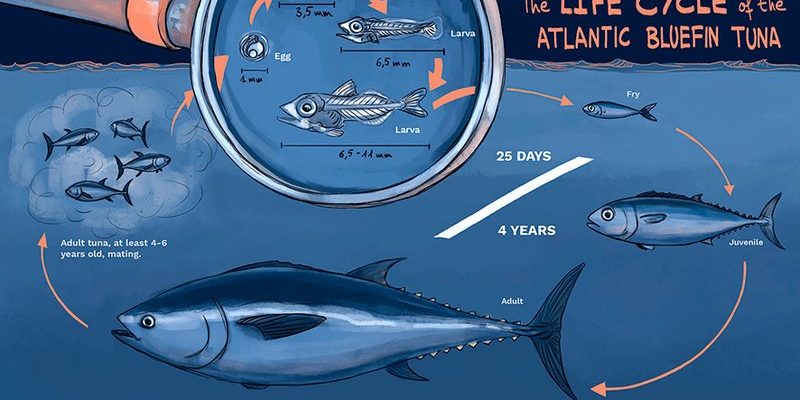
In a way, learning about tuna reproduction is like peeling an onion. There are layers to uncover—from their mating rituals to the challenges they face. In this blog, we’ll swim through the world of tuna breeding, exploring how they reproduce and what environment they thrive in. Ready to plunge into the depths of their aquatic life? Let’s get started!
Life Cycle of the Tuna
The life cycle of tuna is an incredible journey, resembling a fascinating adventure from birth to maturity. Tuna begin life as tiny eggs, and like many fish species, their first steps into the world are rather vulnerable. When the female tuna spawns, she releases thousands of eggs into the water. Each egg, roughly the size of a pinhead, floats away and drifts with the currents.
Here’s the thing: Not all eggs will survive. Predators, environmental conditions, and a host of other factors mean that only a small percentage will grow into healthy larvae. Once hatched, these larvae are called fry. They go through several stages, growing rapidly in a matter of months. Within a year, they can grow to be several inches long, and as they continue to grow, they undergo transformations in both size and coloration.
As they mature, tuna can reach impressive sizes, with some species growing over 6 feet in length! The most common species, like the Atlantic bluefin tuna, can live up to 40 years, significantly influencing their breeding patterns as they age.
Spawning and Mating Behavior
Tuna are known for their unique spawning behaviors, which are both complex and intriguing. Most tuna species prefer to spawn in warm waters, often around the surface where the temperature is just right for their eggs. They generally engage in what is called “broadcast spawning,” a process where both the male and female release their sperm and eggs into the water simultaneously.
Imagine a dance in the ocean: the males chase the females, nudging them to encourage spawning. Shortly after the eggs and sperm meet, fertilization occurs. This natural spectacle can happen in large groups, creating a truly breathtaking scene under the sea.
It’s important to note that some species of tuna, like the bluefin, can spawn multiple times a season. This strategy increases their chances of successful offspring, as releasing eggs at different times allows them to adapt to changing environmental conditions.
Environmental Factors Influencing Reproduction
The environment plays a pivotal role in the successful breeding of tuna. Factors such as water temperature, salinity, and the availability of food can directly impact spawning. Generally, warmer water temperature enhances the likelihood of spawning. Tuna often migrate to specific locations where conditions are ideal.
You might be wondering: How does ocean health affect tuna reproduction? Well, the quality of their environment matters greatly. Pollution, overfishing, and climate change can disrupt their breeding grounds. When warmer waters become too hot or when their favorite spawning areas are threatened, it can lead to fewer eggs being laid and lower survival rates for larvae.
In short, maintaining healthy oceans is vital for tuna populations. Conservation efforts are crucial to ensure these magnificent fish can thrive and continue their life cycles.
Growth and Development Stages
After spawning, tuna eggs take about 24 hours to hatch. Once they emerge, the fry are incredibly small and immediately begin feeding on plankton and tiny marine organisms. At this stage, their survival is critical. If they don’t find enough food, they won’t grow.
As they develop, tuna fry undergo several significant transformations, entering juvenile and then adult stages. During the juvenile phase, your typical tuna starts to look more like the streamlined fish we’re familiar with. They grow rapidly, often doubling in size within just a couple of months.
To visualize this growth: imagine a teenager who goes from being 5 feet tall one summer to 6 feet by the next. Fast growth is essential for tunas to avoid predators, as larger fish are less likely to be eaten. In fact, this rapid growth can continue until they reach their full size, making tuna one of the fastest-growing fish available.
Challenges in Breeding and Survival
While tuna are designed for survival, they face numerous challenges that threaten their breeding and overall existence. Overfishing remains one of the primary concerns, especially for species like the Atlantic bluefin. Heavy fishing pressures can deplete populations, making it tough for them to reproduce effectively.
Additionally, climate change is creating unpredictable conditions in their spawning areas. Changes in water temperature and ocean currents can impact where tuna can successfully breed.
Efforts are being made worldwide to ensure sustainable fishing practices are adopted, and marine reserves are established to protect spawning grounds. By understanding these challenges, we can better appreciate the delicate balance of marine ecosystems and the role tuna play within them.
Conservation Efforts for Tuna Populations
In the face of these challenges, various organizations and governments are stepping up to take action. Conservation efforts focus on creating marine protected areas, regulating fishing quotas, and researching tuna breeding habits to monitor population health.
Programs promoting sustainable fishing practices are also gaining traction. Fishermen are being educated about the long-term benefits of preserving tuna stocks, which can lead to healthier oceans and better fishing yields in the future.
A successful example of conservation in action is the Atlantic bluefin tuna recovery program, which aims to rebuild their populations by enforcing stricter fishing regulations and fostering breeding in both wild and controlled environments.
By taking part in these initiatives, we can help ensure that future generations continue to marvel at these remarkable fish.
The Future of Tuna Breeding
As we look toward the future, the health of tuna populations depends significantly on our actions today. Awareness is key. The more we learn about tuna breeding and reproduction, the better equipped we are to protect them.
As ocean conditions change and challenges increase, scientists are continually exploring innovative ways to support tuna populations. This might include breeding programs, habitat restoration, or genetic research to better understand their resilience and adaptability.
In the end, it’s a shared responsibility. By making informed choices—like supporting sustainable seafood, reducing plastic pollution, and advocating for marine protection—we can all play a part in securing a brighter future for tuna and our oceans.
Breeding and reproduction of tuna hold vital importance not only for the species themselves but also for marine ecosystems and the health of our planet. The next time you enjoy seafood or ponder the ocean’s mysteries, remember the fascinating life cycle of tuna and the ongoing efforts to protect these extraordinary fish.

